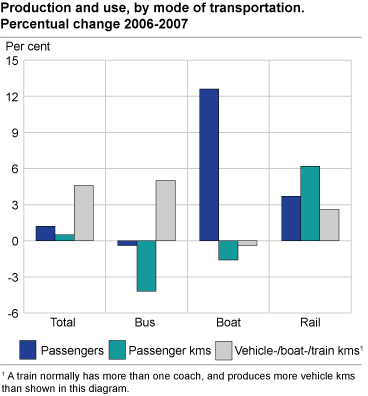Content
Published:
This is an archived release.
Increased use of public transport
There was an increase of nearly 6 million passengers travelling by bus, boat and rail in 2007 compared with 2006. All growth was by boat and rail.
There were 458 million fares in public transportation in 2007, a small growth of 1.2 per cent. The increase was strongest in the boat sector (12.6 per cent) and more modest for rail transportation (3.7 per cent). Transportation by bus decreased by 0.4 per cent.
Vehicle-/boat-/train kilometres increased by almost 5 per cent to more than 392 million kilometres. Most of the growth came from bus companies.
Average length of fares by boat was considerably reduced from above 28 kilometres to less than 25 kilometres.
Stagnant bus use in urban areas
After a fine growth of passengers from 2005 to 2006, fares by bus in major city areas decreased by 3 million in 2007. Other routes had a slight increase.
Bus companies received public subsidies of 4 billion NOK, a growth of more than 600 million. Almost half of this growth was addressed to routes in major city areas.
Steady growth for transport on rails
More than half of the 5.5 billion new passengers in 2007 used suburban railways, urban tramways and the Airport Express. Ordinary railways exceeded the 50 million mark by good margin, and total number of fares on rails reached 160 million.
Difficult comparability over time
Both boat- and bus sectors has had big changes in structure, technology and types of contracts. This makes comparing the numbers over time more difficult.
Tables:
Contact
-
Jardar Andersen
E-mail: jardar.andersen@ssb.no
tel.: (+47) 99 70 08 04

